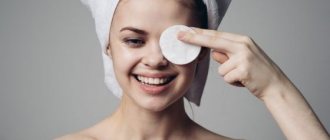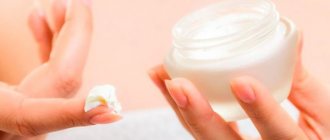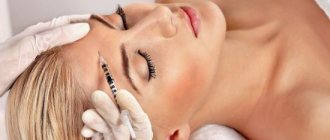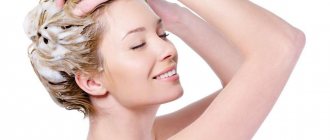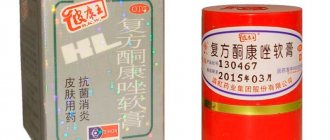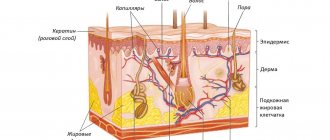Hormones are organic compounds that affect all systems of the body. Human development, both physically and intellectually, depends on their level and activity in the blood.
The influence of hormones on the female body is especially great because its reproductive function depends on them. They have one of the determining influences on the condition of women's skin and hair.
The following hormones are known, the activity of which determines the condition of women’s skin:
- estrogen;
- androgen and testosterone;
- progesterone.
Estrogen and the epidermis
Estrogen is a typical female hormone. It is its action that determines a woman’s figure and the timbre of her voice. It has a special effect on the condition of women’s facial skin. If the concentration of estrogen in a woman’s blood is normal, then she has the following positive signs:
- the skin is smooth and elastic;
- the pores on the skin are narrowed, there is no acne;
- due to active cell division, the skin is constantly renewed and remains elastic;
- activity of the sebaceous glands is reduced;
- stable production of hyaluronic acid, which is responsible for skin hydration;
- Body hair growth is slow.
An excess of estrogen in a woman’s body affects her figure, the skin of the face becomes greasy, resulting in acne. Its deficiency threatens the manifestation of masculine characteristics in a woman: abundant growth of body hair, deepening of the voice. In such cases, tests are required and an appropriate course of treatment is prescribed. As a rule, treatment involves taking medications in the form of tablets.
Estrogens
The average female phenotype depends on estrogens - for example, the tendency to accumulate fat on the hips and other features of the figure. Estrogens are involved in the renewal of skin and hair cells. At the normal speed of this process, the skin remains elastic and hydrated - and contracts well after sudden weight changes.
With an excess of estrogen, problems with blood vessels may appear (for example, varicose veins or vascular networks in the legs), and body weight may also increase sharply. Lack of estrogen in women can manifest as loss of strength, excessive and uncharacteristic hair growth, and decreased libido.
Androgen and epidermis
Androgen, unlike estrogen, is a typical representative of male hormones. But it is also present in the female body. The main representative of androgenic hormones is testosterone. And if it is especially important for the male body, then it affects the female body more negatively.
With an increase in its concentration in a woman’s blood, the following symptoms appear:
- increased oiliness of the skin of the face;
- profuse hair growth on the face and other parts of the body.
The shortage also does not have the best effect on the condition of women’s skin, which can result in dryness. But still, an excess of androgen has a much more negative effect on the female body than its deficiency.
Are hormonal ointments safe?
This question concerns all women suffering from skin diseases. Hormonal ointment or a more gentle lotion can quickly cope with the disease. However, many dermatologist patients outright refuse the prescribed medication, fearing that it will do them much more harm than good.
There really is some truth to these fears. Even in small dosages with short-term use, glucocorticoid-based drugs can cause some unpleasant consequences:
- Slower wound healing, especially in areas where ointment is applied.
- In places where the medicine is applied, the skin becomes thinner, dry and painful. This occurs because the hormones contained in the drugs inhibit the production of callogens necessary for skin elasticity.
- Some people develop purple stretch marks, so-called “striae,” in these areas.
- The vessels may dilate, thereby causing capillary “stars”.
- When applying ointment to the face, a common consequence is the appearance of pimples and blackheads, especially on the chin and around the lips.
- It is especially dangerous to treat the skin around the eyes with such drugs for a long time: this can cause vision deterioration, and later lead to the appearance of glaucoma or cataracts.
- Pigmentation is often disrupted (this is expressed both in dark spots and skin discoloration).
- In extremely rare cases, microscopic wounds and ulcers may even appear (if they appear, you should immediately consult a doctor, who will most likely try to find another medicine that does not affect metabolism).
This is why hormonal ointments are dangerous - they have such a profound effect on the body that one cured problem can be replaced by a good dozen others, not so dangerous, but also not very pleasant. Absorbed into the skin, they enter the bloodstream and affect the functioning of the adrenal glands, which is where the lion's share of the hormones necessary for human life is produced.
That is why hormone-based medications can only be used as prescribed by a dermatologist. You should not change the dosage of the drug at your own discretion. At best, this will simply negate all the positive effects of the treatment. At worst, it will cause all sorts of complications.
Another danger posed by hormonal ointment is that the body becomes accustomed to the amount of artificially administered hormones. With prolonged use (and sometimes it takes a lot of time to treat seborrheic dermatitis, eczema, allergies or lichen), the so-called “hormonal ointment withdrawal syndrome” occurs - a painful reaction to giving up the usual medication. This can be expressed in different ways: a rash, redness, or even the return of the problem for which, in fact, the drug was prescribed. These side effects are especially noticeable in children and adolescents.
The advantage of such medications is that after completing the course of treatment, the body gradually returns to its usual level of hormone production.
Progesterone and the epidermis
Progesterone is a special hormone. Most often it is effective and useful in pregnant women. The active phase of progesterone action occurs during the premenstrual and menstrual cycle itself. During this period, progesterone has a particularly strong effect on the condition of hair and facial skin in women. This is expressed as follows:
- the appearance of swelling on the face and bags under the eyes as a result of stagnation of fluid in the body;
- the skin on the face may become too stretchy;
- increased skin greasiness;
- the appearance of pigment spots.
The reason for the special activity of progesterone can also be a woman’s poor lifestyle and diet.
Androgen, progesterone, and estrogen are produced unevenly in the female body. It all depends on the stage of her life. Thus, during adolescence, estrogen production increases, and after 45 years, more androgens are produced. Progesterone suppresses estrogen during menstruation. Its effect on the body resembles the effect of testosterone. Progesterone acts as a precursor to estrogen and androgen.
Progesterone
Every month, progesterone prepares the female body for pregnancy, and if pregnancy occurs, it helps to preserve and bear the child until the placenta takes over this function. The work of this hormone also affects the appearance: an increase in progesterone levels leads to fluid retention and swelling. In addition, the permeability of the vascular wall increases, and as a result the skin becomes more stretchable and prone to rashes, and the likelihood of pigmentation increases. An extra couple of kilograms shortly before menstruation is due to progesterone. Thanks to this hormone for all the favorite symptoms of PMS: irritability, short temper, touchiness, tearfulness and lethargy.
An increase in progesterone levels in the last phase of the menstrual cycle is normal. You can suspect that there is too much of it on other days if there is obvious stretchability of the skin, swelling, increased cellulite (this occurs due to fluid retention), mood swings, and hyperpigmentation. A lack of progesterone may be indicated by too long menstruation, brittle nails and hair.
The influence of other hormones on women's skin
The interaction between female hormones and skin is multifaceted. Hormones such as:
- serotonin;
- follicle-stimulating hormone;
- oxytocin;
- luteinizing hormone;
- prolactin.
Serotonin is often called the “happiness hormone”. It is especially present in the male body. It has more negative effects on women than positive ones. But its deficiency can cause dull skin on the face.
Follicle stimulating hormone is closely related to sexual desire. It is this substance that is released in large quantities into the blood during ovulation in women. It is also closely associated with stimulating estrogen production, which is very beneficial for women.
Oxytocin is beneficial for the epidermis, as it actively absorbs glucose. As you know, excess sugar in the blood leads to an increase in the number of bacteria on the face, which contributes to the appearance of inflammation on it in the form of pimples and acne.
Luteinizing hormones also promote estrogen production. They are beneficial for the health of the epidermis, but their excess is fraught with the same consequences as with a large amount of estrogen in the blood.
Prolactin, like testosterone, more often has a negative effect on women’s facial skin and hair than a positive one. It is also a common cause of infertility in women. When there is an excess of it, the skin becomes greasy and with a large number of acne. Prolactin in excess contributes to the slow removal of water from the body, as a result of which swelling may appear on a woman’s face.
Effects of insulin, thyroxine, dehydroepiandrosterone and somatotropin
It should be noted the influence of hormones on the skin of this group;
- Insulin is responsible for the concentration of sugar in the blood. When deficient, it causes diabetes mellitus, in which the skin becomes pale and excessively sticky.
- Thyroxine is involved in the growth of hair on the head. If a woman experiences their loss, as well as eyebrow loss, then this is a direct sign of thyroxine deficiency in the blood. The lack of this hormone indicates the presence of heaviness of the eyelids, blurring of the face, and dryness of the epidermis.
- Dehydroepiandrosterone is produced less frequently in older people. It is responsible for the firmness of the skin. It also produces antioxidants and participates in the healing process of skin wounds. A small amount of it leads to the appearance of skin pigments, wrinkles, sagging, and damage heals more slowly.
- Somatotropin is rightly called growth hormone. It is what helps give facial skin firmness and tone. If it is not produced enough, the skin folds in the chin and neck area begin to sag greatly, and vertical wrinkles appear on the cheeks. Somatotropin is produced during sleep.
Forms of negative effects of hormones on the epidermis
Common forms of negative hormone effects include:
- acne before menstruation;
- acne;
- menopause.
In the first case, the rash may appear due to weak estrogen production. Before the onset of menstruation, the female body experiences an increase in estrogen levels. Then its amount in the blood decreases, and is replaced by increased production of progesterone. This hormone is known to regulate estrogen production. At the same time, women experience all the signs of skin diseases that occur with an excess of androgens in the blood.
Not only teenagers, but also older women are susceptible to acne. Unlike premenstrual rash, acne can occur at any time. And this does not depend on the woman’s menstrual cycle. It is worth noting that acne occurs only from an excess of androgens in the blood, since the ovaries and adrenal glands in women produce only half of all androgenic hormones. The rest are produced by the epidermis itself, resulting in acne and pimples on the face. Acne can occur on both oily and dry skin. Predisposition to this disease is associated not only with hormones, but with heredity and race.
During menopause in women, which occurs after 40 years, there is a hormonal imbalance in the body. Estrogen is produced in smaller quantities, and testosterone begins to predominate in the blood. The consequence is roughening of the skin, the appearance of acne, and hair growth. The facial skin is poorly moisturized and wrinkles appear. For this reason, at this age it is necessary to take hormonal medications containing estrogen.
Teenage years
For some, this period was unbearable, while others endured it without much harm to themselves. This is all individual, but changes in hormonal levels during puberty are very important. This age is defined by the transitional stage of physical maturation and psychosocial development, usually from puberty to adulthood. However, during puberty, estrogen, progesterone and testosterone are produced, which in turn can cause the sebaceous glands to produce more sebum, which can lead to acne. Almost every teenager can develop acne, but the level of acne varies greatly (but this does not mean that everyone at this age will suffer this fate).
Solution
Research shows that the risk of developing acne increases in teenagers with a higher BMI (body mass index). High in fatty and sugary foods, the stereotypical teenage diet of sugary drinks and fast food stimulates the production of fats in the epidermis of the skin, as well as inflammation, which ultimately leads to acne. Eating a healthy, balanced diet is essential to maintaining proper hormonal levels.
It's also important to keep your skin hydrated, but make sure you choose a non-comedogenic (non-pore-clogging) moisturizer, otherwise you'll end up with more skin problems. There are many treatments for acne, such as using creams containing benzoyl peroxide. But before you begin treatment, you should consult with a dermatologist or your cosmetologist, who can develop an individual treatment plan for you.
Overcoming the negative effects of hormones on women's skin
It is important for any woman to know how to deal with hormonal manifestations such as oily skin.
There can be many reasons for oily skin:
- excess weight;
- diseases of the intestines, stomach;
- stress;
- malfunction of the thyroid gland;
- food containing fatty, spicy, carbohydrate-rich foods;
- presence of gynecological infections;
- liver problems;
- drinking alcohol and smoking.
To this end, it is important to follow the following recommendations:
- reduce drinking tea, coffee and carbonated drinks, replace everything with water with lemon;
- wash your face first with warm, then with cool water 2 times a day;
- split meal times and portions;
- take estrogen after 40-45 years;
- wipe your face with pieces of ice to narrow the pores, wash with ice water;
- exercise;
- avoid stress;
- do not wash your face with hot water and do not steam the skin on your face;
- wipe the skin on the face with a solution of hydrochloric acid (0.5%) twice a day;
- change bed linen more often, as there are remnants of dead epidermis and hair on it, clogging healthy skin;
- use less cosmetics and wash them off at night.
